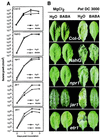Potentiation of pathogen-specific defense mechanisms in Arabidopsis by beta -aminobutyric acid
- PMID: 11058166
- PMCID: PMC18865
- DOI: 10.1073/pnas.230416897
Potentiation of pathogen-specific defense mechanisms in Arabidopsis by beta -aminobutyric acid
Abstract
The nonprotein amino acids gamma-aminobutyric acid (GABA) and beta-aminobutyric acid (BABA) have known biological effects in animals and plants. Their mode of action has been the object of thorough research in animals but remains unclear in plants. Our objective was to study the mode of action of BABA in the protection of Arabidopis plants against virulent pathogens. BABA protected Arabidopsis against the oomycete pathogen Peronospora parasitica through activation of natural defense mechanisms of the plant such as callose deposition, the hypersensitive response, and the formation of trailing necroses. BABA was still fully protective against P. parasitica in transgenic plants or mutants impaired in the salicylic acid, jasmonic acid, and ethylene signaling pathways. Treatment with BABA did not induce the accumulation of mRNA of the systemic acquired resistance (SAR)-associated PR-1 and the ethylene- and jasmonic acid-dependent PDF1.2 genes. However, BABA potentiated the accumulation of PR-1 mRNA after attack by virulent pathogenic bacteria. As a result, BABA-treated Arabidopsis plants were less diseased compared with the untreated control. In the case of bacteria, BABA protected mutants insensitive to jasmonic acid and ethylene but was not active in plants impaired in the SAR transduction pathway. Thus, BABA protects Arabidopsis against different virulent pathogens by potentiating pathogen-specific plant resistance mechanisms. In addition, we provide evidence that BABA-mediated papilla formation after P. parasitica infection is independent of the SAR signaling pathway.
Figures



Similar articles
-
beta-Aminobutyric acid-induced protection of Arabidopsis against the necrotrophic fungus Botrytis cinerea.Plant Physiol. 2001 Jun;126(2):517-23. doi: 10.1104/pp.126.2.517. Plant Physiol. 2001. PMID: 11402183 Free PMC article.
-
Beta-amino-butyric acid-induced resistance against necrotrophic pathogens is based on ABA-dependent priming for callose.Plant J. 2004 Apr;38(1):119-30. doi: 10.1111/j.1365-313X.2004.02028.x. Plant J. 2004. PMID: 15053765
-
Dissecting the beta-aminobutyric acid-induced priming phenomenon in Arabidopsis.Plant Cell. 2005 Mar;17(3):987-99. doi: 10.1105/tpc.104.029728. Epub 2005 Feb 18. Plant Cell. 2005. PMID: 15722464 Free PMC article.
-
Systemic acquired resistance in crop protection: from nature to a chemical approach.J Agric Food Chem. 2003 Jul 30;51(16):4487-503. doi: 10.1021/jf030025s. J Agric Food Chem. 2003. PMID: 14705870 Review.
-
Arabidopsis as a model host for studying plant-pathogen interactions.Trends Microbiol. 1993 Oct;1(7):265-70. doi: 10.1016/0966-842x(93)90049-w. Trends Microbiol. 1993. PMID: 8162407 Review.
Cited by
-
CaLecRK-S.5, a pepper L-type lectin receptor kinase gene, confers broad-spectrum resistance by activating priming.J Exp Bot. 2016 Oct;67(19):5725-5741. doi: 10.1093/jxb/erw336. Epub 2016 Sep 19. J Exp Bot. 2016. PMID: 27647723 Free PMC article.
-
Enhancing Arabidopsis salt and drought stress tolerance by chemical priming for its abscisic acid responses.Plant Physiol. 2005 Sep;139(1):267-74. doi: 10.1104/pp.105.065698. Epub 2005 Aug 19. Plant Physiol. 2005. PMID: 16113213 Free PMC article.
-
Spent growth medium of Pantoea agglomerans primes wheat suspension cells for augmented accumulation of hydrogen peroxide and enhanced peroxidase activity upon elicitation.Planta. 2006 Sep;224(4):963-70. doi: 10.1007/s00425-006-0271-7. Epub 2006 Apr 5. Planta. 2006. PMID: 16596409
-
Benzothiadiazole-induced priming for potentiated responses to pathogen infection, wounding, and infiltration of water into leaves requires the NPR1/NIM1 gene in Arabidopsis.Plant Physiol. 2002 Mar;128(3):1046-56. doi: 10.1104/pp.010744. Plant Physiol. 2002. PMID: 11891259 Free PMC article.
-
beta-Aminobutyric acid-induced protection of Arabidopsis against the necrotrophic fungus Botrytis cinerea.Plant Physiol. 2001 Jun;126(2):517-23. doi: 10.1104/pp.126.2.517. Plant Physiol. 2001. PMID: 11402183 Free PMC article.
References
Publication types
MeSH terms
Substances
LinkOut - more resources
Full Text Sources
Other Literature Sources
Molecular Biology Databases
Research Materials
Miscellaneous

